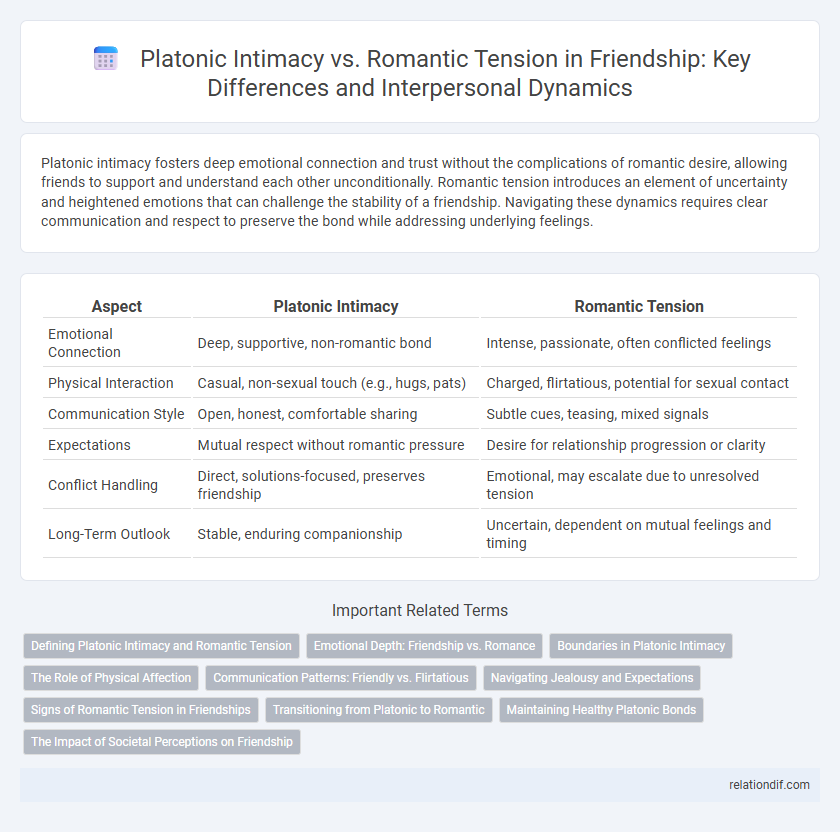Platonic intimacy fosters deep emotional connection and trust without the complications of romantic desire, allowing friends to support and understand each other unconditionally. Romantic tension introduces an element of uncertainty and heightened emotions that can challenge the stability of a friendship. Navigating these dynamics requires clear communication and respect to preserve the bond while addressing underlying feelings.
Table of Comparison
| Aspect | Platonic Intimacy | Romantic Tension |
|---|---|---|
| Emotional Connection | Deep, supportive, non-romantic bond | Intense, passionate, often conflicted feelings |
| Physical Interaction | Casual, non-sexual touch (e.g., hugs, pats) | Charged, flirtatious, potential for sexual contact |
| Communication Style | Open, honest, comfortable sharing | Subtle cues, teasing, mixed signals |
| Expectations | Mutual respect without romantic pressure | Desire for relationship progression or clarity |
| Conflict Handling | Direct, solutions-focused, preserves friendship | Emotional, may escalate due to unresolved tension |
| Long-Term Outlook | Stable, enduring companionship | Uncertain, dependent on mutual feelings and timing |
Defining Platonic Intimacy and Romantic Tension
Platonic intimacy is characterized by deep emotional connection, trust, and affectionate closeness without sexual or romantic involvement, fostering strong bonds through shared experiences and mutual understanding. Romantic tension involves an undercurrent of attraction and desire that complicates interactions, blending emotional intimacy with potential or implied romantic or sexual interest. Defining these concepts highlights the contrast between purely emotional connection in platonic relationships and the mixed signals or expectations present in romantic tension.
Emotional Depth: Friendship vs. Romance
Platonic intimacy in friendship fosters emotional depth through trust, vulnerability, and mutual understanding without physical attraction, creating a stable foundation for lasting bonds. Romantic tension often mixes intense emotions with passion and desire, introducing complexity and potential uncertainty in communication and connection. Emotional depth in friendships prioritizes consistent support and shared experiences, while romance weaves deeper layers of attachment influenced by physical and emotional interplay.
Boundaries in Platonic Intimacy
Platonic intimacy thrives on clear boundaries that prioritize emotional closeness without physical or romantic involvement, fostering trust and mutual respect. Establishing these limits helps prevent misunderstandings and preserves the integrity of the friendship by maintaining space for individual autonomy. Consistent communication about boundaries ensures both parties feel safe and valued, strengthening the non-romantic connection.
The Role of Physical Affection
Physical affection in platonic intimacy serves as a powerful expression of trust and emotional support without implying romantic intent, fostering deeper bonds through gestures like hugs or casual touches. In contrast, romantic tension often heightens sensitivity to physical contact, where each touch carries potential emotional significance or signals attraction. Understanding these distinctions helps navigate friendships gracefully, ensuring comfort and respect within shared boundaries.
Communication Patterns: Friendly vs. Flirtatious
Platonic intimacy features clear, supportive communication patterns characterized by honest sharing and empathetic listening, fostering trust and emotional security without romantic implications. Romantic tension involves flirtatious dialogue, including playful teasing, suggestive comments, and heightened attentiveness that signal attraction and desire. Distinguishing these communication styles helps maintain boundaries in friendships while recognizing evolving emotional undercurrents.
Navigating Jealousy and Expectations
Navigating jealousy and expectations in friendship requires clear communication to distinguish platonic intimacy from romantic tension. Establishing boundaries helps prevent misunderstandings while honoring emotional closeness without crossing into romantic territory. Recognizing and addressing subtle feelings early maintains trust and preserves the core friendship.
Signs of Romantic Tension in Friendships
Signs of romantic tension in friendships include prolonged eye contact, frequent physical touch, and increased emotional vulnerability beyond typical platonic boundaries. Conversations often shift toward personal topics, with subtle flirtations and a heightened sense of anticipation during interactions. Persistent feelings of jealousy when either friend dates others may also indicate underlying romantic interest.
Transitioning from Platonic to Romantic
Transitioning from platonic intimacy to romantic tension involves navigating the delicate shift where deep emotional connection begins to include romantic desire. This transition often challenges existing boundaries and requires clear communication to manage expectations and preserve trust. Understanding nuanced cues and mutual feelings plays a critical role in evolving friendship dynamics into romantic relationships.
Maintaining Healthy Platonic Bonds
Maintaining healthy platonic bonds requires clear communication and respect for emotional boundaries to prevent romantic tension from disrupting friendship dynamics. Emphasizing mutual trust and shared experiences strengthens the connection without the complications of romantic expectations. Prioritizing empathy and consistent support fosters intimacy that remains purely platonic, ensuring longevity and emotional safety within the relationship.
The Impact of Societal Perceptions on Friendship
Societal perceptions often blur the boundaries between platonic intimacy and romantic tension, influencing how friendships are perceived and valued. Cultural norms and media portrayals frequently prioritize romantic relationships, leading to misunderstandings and stigmatization of close same-gender friendships. This impact shapes individuals' comfort levels in expressing deep emotional bonds without fear of judgment or misinterpretation.
Platonic intimacy vs Romantic tension Infographic

 relationdif.com
relationdif.com